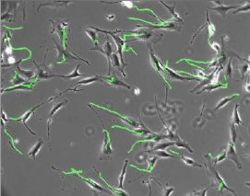Cell motility
From Wiki CEINGE
A morphological and functional study of cell motility was developed by using
experimental systems able to observe cells in conditions as close as possible to
physiological ones. Cell motion was studied by video time-lapse microscopy
which allows to dinamically study cultured cells by acquiring series images
at regular time steps and by quantitatively evaluating cell movement.
The cell motility tool
In order to characterize motility, was developed software able to draw the path followed by a cell by a list of spatial coordinates and to carry out quantitative analysis of the paths by calculating average speed, motion coherency, direction and other parameters. The first results contribute to associate to different cell lines specific motion features; but a subsequent punctual analysis is included to study sub-cellular elements in order to make visible their different ability to move into the cytoplasm in response to distinct stimuli, a wound line as example. The program is wrote by PHP language, that allows the development of rather object-oriented programs and offers a high degree of easy customization. It takes in input a text file containing cartesian coordinates of each object to follow, time after time. This file is the result of a computer assisted recording of the subsequent position of the elements, stored as coordinates x and y. Starting from the ensemble of coordinates of each object to analyze, the program calculates distances and directions at each time step; then average speed, direction and tortuosity are evaluated both for each object during the whole observation period, as for the population at each time step. The list of coordinates is moreover used to draw the paths covered by the elements of the population studied. Visualization of followed paths may be superimposed on the original images and vectors, describing the observed movements, may be calculated and display in the same way. Data from the experimental observation are stored in files that may be subsequently analyzed with commonly available tools such as spreadsheet or graphic application.
Experimental system
Taking advantage of these techniques a number of normal and transformed cell lines were studied by culturing them on plates, and observing them under basal conditions or after stimuli. The opportunity to dinamically and quantitatively study cell motility, allowed to highlight the effects of single molecules. Cells transformed by overexpression of constitutively activated variants of Ras and Src, were studied in order to determine the effect of transformation induced by activating their respective pathways on cell motility and to evaluate the relationship beetwen these effects and the ability of transformed cells to form methastasis in vivo by moving to new anchorage sites.

